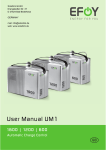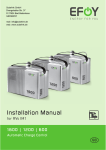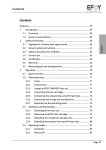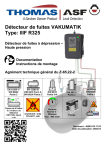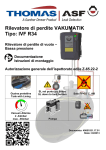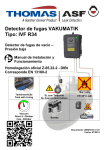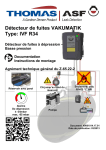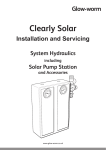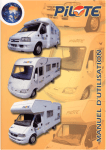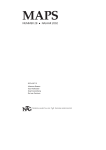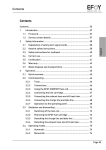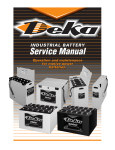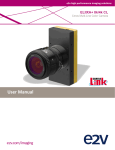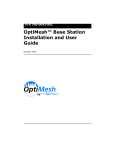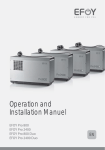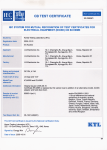Download User Manual UM1 - campervanstuff.com
Transcript
User Manual UM1 1600 | 1200 | 600 Automatic Charge Control GB 1. Introduction Introduction 1.1 Foreword Thank you for purchasing an EFOY product. We hope that you will enjoy your new unit. Please read these instructions first before using. Should you have any questions about installation or operation, please consult the EFOY hotline. SFC Smart Fuel Cell AG Eugen-Sänger-Ring 4 D-85649 Brunnthal-Nord Hotline: +49 89 673 5920 Freecall: 00800 732 762 78* Fax: +49 89 673 592 369 [email protected] www.efoy.com *The toll-free number is available in the following countries: Germany, Belgium, Denmark, France, Great Britain, Italy, the Netherlands, Norway, Austria, Sweden, Switzerland and Spain. 3 UM1-GB-061213 User Manual 1. 1. Introduction 1.2 Safety Information Read the instructions before operating and keep them nearby. Be sure to follow all directions in the manual. Do not open unit or fuel cartridges. Do not use force to open cartridges and do not refill them. Any modifications to the unit may affect safe operation, will lead to a loss of license and will void the warranty Use only original EFOY equipment. Do not store unit and fuel cartridges at temperatures above 45° C. Do not operate at temperatures above 40° C. Keep away from heat and direct sunlight. Store the unit where there is no danger of freezing, or use the automatic antifreeze feature. Do not smoke when handling the unit or the fuel cartridges. Keep away from heat and open flame. There is a danger of fire if methanol leaks out following an accident, or if the unit or the fuel cartridge has been damaged. Keep away from open fire and make sure area is well ventilated. Small amounts of methanol which may leak out will evaporate without leaving any residue. Keep unit and fuel cartridges (including empty or partially filled cartridges) out of children’s reach. Operate the unit only in accordance with instructions and keep operating area well ventilated. Do not block exhaust. Avoid inhaling exhaust fumes directly or for prolonged periods of time. 4 1. Introduction There is no risk of coming into contact with methanol provided that you handle the unit and fuel cartridges in accordance with instructions. We are required by law to print the following notice. Methanol is toxic if inhaled, ingested or if it comes into contact with skin. Irreparable damage may occur if inhaled, ingested or if it comes into contact with skin. In the event of an accident or if nausea occurs, consult a physician immediately. Be sure to bring the fuel cartridge label or these instructions to the consultation. (A caution concerning methanol can be found in the appendix.) System exhaust may contain harmful components. Avoid inhaling exhaust directly or for prolonged periods of time. Use the exhaust hose to conduct exhaust gases to the exterior. Improper use or improper connection to other electrical devices may result in damage. In addition to these safety instructions, please observe the passages in bold type. Otherwise, you may endanger yourself and others. 5 1. Introduction 1.3 Normal Operation The EFOY 600, EFOY 1200 and EFOY 1600 are automatic charging devices for 12V lead batteries. The unit may be used only to charge lead batteries that conform to the specifications in Chapter 3.4, S. 12). The specifications allow for solid-state operation (see Chapter 3.4) on motor vehicles. Operate only with original-equipment EFOY fuel cartridges. The unit is not intended for emergency medical power generation, or for powering life-sustaining or agricultural devices. Do not operate unit if housing is damaged. 1.4 Declaration of Conformity SFC Smart Fuel Cell AG, Eugen-Saenger-Ring 4, 85649 Brunnthal-Nord declares that the EFOY 600, EFOY 1200 and the EFOY 1600 conform to the European Community’s 89/336/EWG guidelines for electro-magnetic compatibility. The following norms apply: DIN EN 610006-1, DIN EN 61000-6-3 6 1. Introduction 1.5 E 24 Seals of Approval These units have been tested in accordance with ECE Regulation No. 10 for electro-magnetic compatibility. Operation in motor vehicles is permitted. Approval number: E24 10R-020234 These units have undergone voluntary testing by TÜV SÜD for conformity with the basic requirements of IEC 62282-5 and have been awarded the seal of approval for product safety. 1.6 Warranty 1. Warranty SFC provides a) a 36-month warranty for up to 3,000 hours of operation. The warranty covers defects caused by materials or by the manufacturing process, provided that the manufacturer has a written registration of the unit on record. The unit must be registered online or by sending in the warranty card. The unit must be registered no later than 4 weeks after date of purchase. Registration is subject to the purchaser agreeing to have his data recorded by the manufacturer. b) a 24-month warranty for up to 3,000 hours of operation. The warranty covers defects caused by materials or by the manufacturing process should there be no registration of the unit on record as described in warranty 1a. The warranty does not extend to cover improper use of the unit or operation that is not in accordance with the user manual, in particular: If fuel cartridges other than original EFOY fuel cartridges are used, Inappropriate handling, Water damage, Improper transportation, If the unit has been opened. 7 1. Introduction 2. Extent of the warranty The warranty covers defects (see 1. Warranty) from the time of sale. The manufacturer shall remedy such defects by either repair or replacement (updated model where applicable) as he deems appropriate. Should the manufacturer provide a warranty, the warranty period with regard to repair or replacement parts shall not recommence from the time of service. Instead, the warranty from time of sale will remain in force. Any other claims, in particular claims for damages on the part of the purchaser or a third party, are invalid. The provisions of the product liability law remain in effect as well as any claims against the manufacturer pertaining to warrantees remain in force as provide by law. The warranty does not extend to any extra costs associated with mounting or dismounting the unit such as disassembling furniture or parts of a motor vehicle. 3. In Case of Claim Always notify the EFOY service center in writing in case of malfunction. Please describe the defect in detail. Please also indicate serial number and include the original invoice. The purchaser must bring or send the unit to the manufacturer at his own risk so that the manufacturer can determine whether the defect is covered by the warranty. The unit must be sent to the factory as freight. If the defect is covered by the warranty, the factory shall assume the transportation costs. Should the defect not be covered by warranty, the manufacturer shall notify the customer, informing the customer of what repair costs the manufacturer shall not assume. The customer shall bear the cost of transportation in this case. 8 1. Introduction The manufacturer’s address is: SFC Smart Fuel Cell AG Eugen-Saenger-Ring 4 D-85649 Brunnthal Tel.: +49 89 / 673 59 20 Free Call: 00800 / 73 27 62 78** Fax.: +49 89 / 673 592 369 [email protected] www.efoy.com Service EFOY customer service is available for technical inquiries concerning EFOY fuel cells during normal business hours at the following numbers: Toll-free number: 00800/73 27 62 78* If calling from outside the countries listed below, please dial +49 89 / 673 5920 *The toll-free number is available in the following countries: Germany, Austria, Belgium, Denmark, France, Great Britain, Italy, the Netherlands, Norway, Spain, Sweden and Switzerland. 9 1. Introduction 1.7 Packaging Disposal Packaging protects your unit during shipping. All materials used are environmentally compatible and recyclable. We recommend saving the packaging for eventual winter storage. Should you nevertheless wish to dispose of the packaging, please do so properly. Your dealer or your local recycling center can provide information about proper disposal. Danger of Suffocation! Keep packaging away from children. Plastic wrapping and cartons may cause suffocation. Fuel Cartridges Old Units Sort empty fuel cartridges with plastics. Dispose of partly filled fuel cartridges in the same manner as solvents or paint. Old units are still valuable! Proper disposal can yield valuable raw materials while protecting the environment. The EFOY hotline: Tel.: +49 89 673 5920 or 00800 732 762 78* can advise you about returning old units. 10 2. Table of Contents 2. Table of Contents 1. Introduction 1.1 Foreword 1.2 Safety Information 1.3 Normal Operation 1.4 Declaration of Conformity 1.5 Seals of Approval 1.6 Warranty 1.7 Disposal 3 3 4 6 6 7 7 10 2. Table of Contents 11 3. Configuration 3.1 Standard Equipment 3.2 Overview 3.3 Remote Control 3.4 Specifications 13 13 13 14 15 4. Installation 4.1 Space Requirements 4.2 Securing 4.3 Connecting the Exhaust Hose 4.4 Off-heat duct 4.5 Electrical Connections 4.6 Connecting the Remote Control 4.7 Select Language 17 17 19 20 21 22 23 25 5. Operation 5.1 Connecting the Fuel Cartridge 5.2 Automatic Operation 5.3 Switching on the Fuel Cell 5.4 Display Information 5.5 Remote Operation 5.6 Parallel Operation of Multiple Units 5.7 Switching Off the Fuel Cell 5.8 Automatic Antifreeze Feature 5.9 Storage 26 26 28 29 29 31 31 32 32 33 6. Maintenance 6.1 Service 6.2 Cleaning 35 35 35 7. Troubleshooting 36 11 2. Table of Contents 7.1 7.2 7.3 7.4 7.5 8. Safety Problems and Solutions Problems without Error Messages Changing the Fuse Replacing Service Fluid Appendix 8.1 Accessories and Spare Parts 8.2 Output characteristic 8.3 Material Safety Data Sheet Methanol 12 36 37 39 41 42 43 43 45 46 3. Configuration 3. Configuration 3.1 Standard Equipment The following is standard equipment: Unit Remote control with data line RC1 Fuel-cartridge holder with belt FH 1 Mounting plate with belt MP 1 Exhaust hose (1.5 m) EH 1 Charge line Service-Kit UM1 user manual 3.2 Overview 1 2 3 4 5 6 7 8 Charge line connection Remote-control connection RC 1 Data interface G-fuse 250V 8A M, 5 x 20 mm Fuel-cartridge connection Connection for EH 1 exhaust hose and nozzle for service fluid Cooling inlet (reverse) Warm-air outlet and connection for off-heat duct 13 3. Configuration 3.3 auto reset ! Remote Control 1 2 3 4 5 6 7 Display Information button and language-selection button >> On/Off button Button for automatic operation auto Yellow warning light “Please change fuel cartridge“ Red error warning light Reset button reset 14 3. Configuration 3.4 Specifications Performance Product EFOY 600 EFOY 1200 EFOY 1600 Rating 25 W 50 W 65 W Charge capacity 600 Wh/Day (50 Ah/Day) 1200 Wh/Day (100 Ah/Day) 1600 Wh/Day (130 Ah/Day) Nominal voltage 12 V 12 V 12 V Charging current @ 12 V 2.1 A 4.2 A 5.4 A Turn on threshold* Ubatt < 12.5 V Ubatt < 12.5 V Ubatt < 12.5 V Cut off threshold* Ubatt >14.2 V and Iout < 2.0 A Ubatt >14.2 V and Iout < 2.0 A Ubatt >14.2 V and Iout < 2.0 A Required starting voltage > 10.8 V > 10.8 V > 10.8 V Quiescent current requirement 15 mA 15 mA 15 mA Methanol requirement 1.1 l/kWh 1.1 l/kWh 1.1 l/kWh Compatible batteries 12 V rechargeable (lead-acid or lead-gel) batteries with 40 to 200 Ah capacity General Specifications Sound pressure level at 7 m 20 dB(A) 23 dB(A) 23 dB(A) Weight 6,3 kg 7,1 kg 7,3 kg Dimensions (L x W x H) 43,5 x 20,0 x 27,6 cm * factory setting 15 3. Configuration Environmental conditions Space requirement (L x W x H) 51 x 35 x 30 cm minimum Inclination along the direct axis continual: 15° temporary (<10 min): 35° Inclination along the quadrature axis continual: 15° Operating temperature -20 to +40 °C Start temperature +5 to +40 °C Storage temperature +1 to +45 °C Instrumentation Operation via remote control with four buttons and multilingual display Electrical interface MNL 4-prong plug Type Tyco Electronics AMP Universal Mate-N-Lok (Mfr. No. 350779) Fuse G fuse 250V 8.0A M, 5 x 20 mm 16 4. Installation 4. Installation Securely fasten unit and fuel cartridges when using on board motor vehicles. Do not operate unit if there is danger of explosion. Unit is not watertight. Make sure that no water can enter. Keep unit and fuel cartridges away from children, temperatures in excess of 45° C and direct sunlight. 4.1 Space Requirements Please note when installing that operating temperature ranges between –20° C and +40° C. This unit generates heat, thus requiring ventilation. Please take this into account when considering space requirements. Provide for a vent opening measuring at least 10 cm across when installing. Use the off-heat duct (included) to remove warm air. Install only in upright position. Use the mounting plate (included). Make sure that the device does not exceed the maximum inclination. Inclination along the direct axis: continual: 15° temporary (<10min): 35° Inclination along the quadrature axis: continual: 15° 17 4. Installation All electrical connections, the fill opening for service fluid and the fuel cartridge should be easily accessible. Install unit and fuel cartridge at the same level. Make sure that the fuel cartridge is located within reach of the connecting hose (30 cm) and that the hose is neither kinked nor crushed. The fuel-cartridge hose and the exhaust hose may not be damaged. Do not substitute another hose for either of the two. Use only original-equipment EFOY hoses. exhaust Do not place the fuel cartridge in front of the air intake or the exhaust! Place fuel cartridges next to or in front of the unit as illustrated. Do not place any other objects such as reserve fuel cartridges in front of intakes or the exhaust outlet. electrical connection 18 4. Installation 4.2 Securing Securing the unit Select a suitable location as described in Chapter 4.1, paying attention to the dimensions in Chapter 3.4 Specifications. 1. Run the belt in the groove under the mounting plate. 2. Secure the mounting plate tightly to the desired location. Use proper screws and dowels, if necessary, so that the mounting plate cannot shake loose in an accident, for example. 3. Place the unit onto the mounting plate. 4. Strap the unit tightly to the mounting plate. Securing the fuel-cartridge holder Keep fuel cartridge and reserve cartridges away from children, heat and out of direct sunlight. Select a suitable location for the fuel cartridge and reserve cartridges as described in Chapter 4.1 “Space requirements“. Install device and fuel cartridge on the same level. Secure the fuel-cartridge holder with four suitable screws and dowels, if necessary, so that it does not shake loose in an accident, for example. 19 4. Installation 4.3 Connecting the Exhaust Hose The unit converts methanol and oxygen into water and carbon dioxide. The process generates heat, which together with water vapor, carbon dioxide and trace amounts of methanol, must escape. Attach the exhaust hose (included) to conduct by products to the exterior. Remove the cap from the exhaust port. Retain the cap for winter storage or for possible returns. Attach the exhaust hose (included) to the exhaust port. Feed the hose from the chassis to the exterior and use a suitable sealant to seal the opening. The hose may be shortened as needed. Make sure the exhaust hose has no kinks or blockage and that exhaust can escape freely. Exhaust gasses contain moisture and may exceed 60° C, thereby causing scalding. Exhaust byproducts may contain injurious substances. Avoid inhaling exhaust directly or for long periods of time. At no time may siphoning occur in the hose. Make sure that the hose is neither closed nor blocked. The exhaust hose may not be longer than 50 cm in order to prevent freezing in winter. The hose may be up to 150 cm long for summer operation and during transitional seasons. Routing the exhaust hose Up Down 20 Avoid siphoning 4. Installation 4.4 Off-heat duct The off-heat duct (included) extracts warm air so that the unit can also be operated in close quarters. 1 Fasten the off-heat flange (1) to the unit using the presunk screw holes. Attach the off-heat tube (2) to the offheat bow and conduct the tube to the exterior. Should the off-heat bow (3) not be needed, you can remove it from the off-heat flange and attach the off-heat tube directly to the flange. 2 3 1. Off-heat flange 2. Off-heat tube 3. Off-heat bow Make sure that the hose is not crimped and that there is no moisture or foreign objects inside. The hose may be shortened as needed. It may be necessary to use an external face plate to protect the outlet. 21 4. Installation 4.5 Electrical Connections All work should be carried out by qualified technicians in accordance with technical regulations. Improper connections or the use of wrong gauge wires could result in fire. All wires must be properly insulated and have adequate voltage rating. All connections must be tight. The use of uninsulated wires and contacts is not permitted. Use the battery charging line (included). The circuit connecting the battery must contain a fuse. Alternatively, use the fuse (available as optional equipment) to connect the battery. The battery charging cable consists of four leads that must be connected to the battery as follows: Power lead: This lead carries current to the battery. Sense lead: This lead measures battery voltage. Power lead Sense lead To minimize current loss in the leads, the following cross section is recommended, should the battery charging cable, included as standard equipment, be insufficient: Length [m] min. cross section <5m 5 – 10 m 10 – 15 m 2.5 mm² 4 mm² 6 mm² 22 4. Installation + Connect the positive wire + and the positive sensor cord + to the battery fuse. Then connect the battery fuse to the battery’s positive terminal. Sensor lead + + Power lead+ – Power lead - Sensor lead - – Make sure that the polarity is correct (see illustration). Then connect the negative wire – and the negative sensor cord to the battery’s negative terminal. Installation in recreational vehicles (RV) + – See IM1 installation manual for RVs with Electroblock (EBL). 12 V lead 12 Vbattery Bleiakku 4.6 Connecting the Remote Control The remote control (1) displays the current status and is used to control the device. Mount the panel where it is easily accessible such as in the cockpit. If installing the panel flush with the surface of the unit, make sure that there is sufficient opening for the electronic components behind the opening. 1 Use templates for drilling and sawing when flush or surface mounting (2). Use a drill to start the opening and then cut out the rest of the opening with a keyhole or compass saw. 2 Then secure the control panel (1) with four suitable screws (4) and place the frame (3) over the control panel 3 1 2 3 4 4 Control panel Surface mount Frame Screws 23 4. Installation Connect the control panel with the data line (included) or with any commercially available network cable such as a Cat. 5 patch cable. Then insert the plug into the left socket on the unit marked “Remote Control“. The display contains two lines with 16 characters apiece. Automatic Standby The first line provides information as to the operating mode selected: Automatic On Off It also provides information as to the language selection. (See Chapter 4.7) The second line provides information as to the operating status: Standby Charging mode Antifreeze mode Shutting down The second line also indicates operating parameters such as charging current and such maintenance parameters as “Please change fuel cartridge“. 24 4. Installation 4.7 Select Language Press >> on the control panel for 2 seconds. The control panel will display the language currently selected. Deutsch The following languages are available: German (factory setting) English French Italian Dutch Spanish Continue pressing >> until the desired language appears. Then hold >> 2 more seconds in order to set your language choice. 25 5. Operation 5. Operation 5.1 Connecting the Fuel Cartridge For safety’s sake, use only original EFOY fuel cartridges. Do not smoke while changing the cartridge and avoid open flames! Do not expose fuel cartridges to temperatures above 45°C. Do not place the fuel cartridge in front of the air intake or outlet. Original-equipment EFOY fuel cartridges contain EFOYapproved methanol. Even slight impurities in commercially available methanol may cause permanent damage to the unit and may void the warranty. Note: When the cartridge is empty, “Please change fuel cartridge“ will appear on the remote control and the yellow light will blink. The cartridge may be changed while the system is running. Unscrew the empty fuel cartridge and remove. Close each cartridge tightly with the cap after use. EFOY fuel cartridges are intended for one-way use only. They may not be refilled. Sort empty fuel cartridges with plastics. Dispose of partly filled fuel cartridges in the same manner as solvents or paint. 26 5. Operation 1 Place a new sealed original-equipment EFOY fuel cartridge into the fuel-cartridge holder (1). Fasten the belt on the fuel-cartridge holder (2). Do not attach fuel cartridges without a fuel-cartridge holder. Only remove the childproof cap when the new fuel cartridge has been placed into the fuel-cartridge holder (3). Screw the connector onto the new fuel cartridge. 2 Press reset on the control panel to extinguish the yellow warning light and the maintenance message. 3 27 5. Operation 5.2 Automatic Operation Before connecting to the electrical system, make sure the unit has been positioned properly and that the electrical system is protected by fuses (as described in Chapter 4.5.) Do not operate at temperatures above 40° C or below - 20° C. If device has been exposed to temperatures under 0° C without being connected to a battery or with insufficiently filled fuel cartridge (antifreeze), it must stand at room temperature for 24 hours before operating. Make sure that a full fuel cartridge has been connected. Automatic operation will begin the moment that you connect the unit to a battery. The unit will monitor battery voltage by itself. Charging mode The unit charges the battery as needed or assists the battery in providing output. The second line of the display will indicate “charging mode“ as long as the unit is providing voltage to the electrical system. Automatic The device goes through a cold start phase of about 20 minutes before reaching its full rated output. Automatic Start phase Automatic Standby Automatic Please change fuel cartridge If the battery is sufficiently charged and the unit is not providing input, the unit will remain in the standby mode. Should the device detect a malfunction such as an empty fuel cartridge, it will shut down and advise you how to correct the situation. (“Please change fuel cartridge“.) Resume automatic operation using the reset button after the error has been corrected. (See also Chapter 7 Troubleshooting). 28 5. Operation 5.3 Switching on the Fuel Cell If desired, you can switch on the unit manually regardless of the battery voltage. The unit will then be in the “charging mode“. Press on the control panel once if the unit has been switched off, and twice if it is operating in automatic mode. The unit will start up regardless of the battery voltage and will continue charging until it reaches the cutoff point (Ubatt >14,2 V und Iout < 2,0 A). On Charging mode The device will then switch to automatic mode by itself and will only charge if the battery or the demand for power requires it. 5.4 Display Information The second line of the display provides information about normal operation, errors or malfunctions (see Chapter 7). The first line indicates the operating mode selected, such as “Automatic“. Press >> to obtain the following information. Automatic Battery voltage Voltage 13.6 V Automatic 4.6 A Automatic Charging current Please note that the device interrupts power generation briefly several times an hour during normal operation and a charging power of 0.0 A is displayed then. Firmware version Firmware 1200 4.12L 29 5. Operation Automatic Total operating hours Operating hours 500 h Automatic Maintenance messages (see also Chapter 7) Please change fuel cartridge Automatic Charging mode If you have connected the optional cartridge sensor to your unit, a fuel cartridge will appear in the display as soon as a predetermined amount is reached. Always keep a reserve fuel cartridge at the ready. The cartridge need only be changed when the message “Please change cartridge“ appears in the display. The standard display will be restored after about 30 seconds. Alternatively, you can return to the standard display by pressing >> again. By pressing >> for approximately 2 seconds, you will obtain the language menu (see Chapter 4.7 Select Language). 30 5. Operation 5.5 Remote Operation The unit may also be controlled and monitored remotely. In order to do this, you will need either the CC1 cluster controller or the IA1 interface adapter. You can obtain both from your dealer. Automatic An “R” for “remote” will appear in the first line when the unit is operating in remote mode. R Charging mode Automatic You can lock or unlock the unit’s software from a remote location by pressing auto and >> simultaneously. This will warranty that the unit cannot be started by a remote signal. R Charging mode If you have locked the software, a padlock in the first line of the display. 5.6 will appear Parallel Operation of Multiple Units You can harness up to five units in parallel if increased output is needed. Use the optional CC1 cluster controller. Automatic Charging mode P The manual that accompanies the control controller describes the installation and parallel operation of multiple units in detail. Units running in parallel must all be in the same operating mode. For example, all have to be running in automatic mode. Be sure to press the same button on each control panel (such as reset to restart or auto for automatic mode). An “P” for “Parallel” will appear in the first line when the unit is operating in parallel. 31 5. Operation 5.7 Switching Off the Fuel Cell Press device. on the remote control to switch off the The unit will gradually shut down, performing various function checks as it does so: To protect components, the unit must run at least 30 minutes before shutting down. If the unit is shut off beforehand, it will continue running until 30 minutes have elapsed. The message “Shutting down” will appear in the display. Leave the fuel cartridge and the battery connected during this time. Off Shutting down Please note that the fuel cell will only start up if it is connected to an intact battery. The fuel cell will not switch on if the battery is damaged. 5.8 Off Antifreeze mode Automatic Antifreeze Feature This unit features an intelligent antifreeze feature. The unit can keep itself warm at temperatures below 3° C as long as it is connected to a working battery and it is supplied with methanol. If the unit is in antifreeze mode, the message “Antifreeze mode” will appear on the second line. The first line will indicate the current operating mode, for example “Off”. The antifreeze function works only as long as a fuel cartridge and a sufficiently intact battery are connected. The unit will not be able to start if the battery voltage falls below 10.5 volts. Please note that the unit will not recharge the battery if the voltage drops below 10.5 volts. 32 5. Operation Please observe the following maintenance tips for storage and winter operation: 1 To cut energy costs, we recommend dismounting the unit and storing it away from cold if it is to be inactive for longer periods of time. Dismounting is easy; it requires just a few steps, no tools and no particular technical finesse. Store the unit in the original carton. 2 If, despite precautions, the unit does freeze, let it thaw in a warm place for approximately 24 hours before operating. Please note that the unit’s performance may diminish if it freezes repeatedly. Running in straight antifreeze mode, the unit will consume approximately 10 liters of methanol in the course of a five-month Central European winter. 5.9 Storage Press unit. Off Shutting down on the remote control to switch off the Wait until the unit has shut down and the display has disappeared (approx. 30 min.). Unplug the charging line and the data line for the remote control. Store the plugs and lines in a cool, dry place. Do not smoke when handling unit and fuel cartridge. Keep away from open flame! 33 5. Operation Unscrew the fuel cartridge and close it with a cap. Keep all elements clean. Keep unit and fuel cartridges – even empty or partially empty cartridges – away from children. Remove the exhaust hose. Keep it clean and place a cap over the exhaust outlet. Remove the off-heat tube and the off-heat bow if necessary. Release the belt and lift the unit off the mounting plate. Store unit in a cool place; however, the temperature should exceed 1° C because the automatic antifreeze feature will only work if a fuel cartridge is attached along with a sufficiently charged battery. (See Chapter 5.8) If the unit has been exposed to temperatures below 0° C without being connected to a battery and sufficiently filled fuel cartridge (antifreeze), it will have to stand at room temperature for approximately 24 hours before operating. Use a proper box such as the original carton to ship the unit. Use padding to prevent shocks. Transport the unit in an upright position only. 34 6. Maintenance 6. Maintenance 6.1 Service Do not open unit! Unauthorized tampering may jeopardize safe operation and void any warranty. The unit does not contain any components that you can service or repair yourself. The unit is maintenance free under normal operating conditions. Contact SFC if you intend to use it for other than its intended purpose. SFC Smart Fuel Cell AG Eugen-Sänger-Ring 4 D-85649 Brunnthal-Nord Hotline: +49 89 673 5920 Freecall: 00800 732 762 78* [email protected] www.efoy.com *The toll-free number is available in the following countries: Germany, Belgium, Denmark, France, Great Britain, Italy, the Netherlands, Norway, Austria, Sweden, Switzerland and Spain. 6.2 Cleaning Switch off device before cleaning and unplug the battery charging cable. The device is not watertight. Make sure that moisture cannot get inside. Clean only with a soft cloth dampened with a mild detergent. Reconnect the battery charging cable after cleaning so that the antifreeze feature remains activated. (See Chapter 5.8). 35 7. Troubleshooting 7. Troubleshooting 7.1 Safety Do not open unit! It contains no components that you can repair yourself. Contact SFC Smart Fuel Cell AG if you are unable to correct a malfunction using these instructions. SFC Smart Fuel Cell AG Eugen-Sänger-Ring 4 D-85649 Brunnthal-Nord Hotline: +49 89 673 5920 Freecall: 00800 732 762 78* [email protected] www.efoy.com *The toll-free number is available in the following countries: Germany, Belgium, Denmark, France, Great Britain, Italy, the Netherlands, Norway, Austria, Sweden, Switzerland and Spain. 36 7. Troubleshooting 7.2 Problems and Solutions The control panel signals problems via a red and/or yellow light and a running message on the second line of the display. The messages will assist you in solving the problem quickly and easily. Press the reset button on the control panel AFTER the problem has been solved. Under no circumstances should you press the reset button repeatedly. Message Solution Check battery Battery voltage is too low. No connect If battery voltage is under 10.5 V, check connection between unit and battery (see Chapter 4.5). Interruption: Surroundings too warm Ambient temperature is too high. Unit will start automatically as soon as temperature drops below 40° C. Error 10: Please contact service Call the hotline at. Error 11: Please check exhaust hose Check that the exhaust hose has been properly connected and arrange it so that condensation cannot form. Error 12: Please check exhaust hose Freecall: 00800 732 762 78* Hotline: +49 89 673 5920 [email protected] www.efoy.com Check for kinks. Clean hose if necessary and keep opening clear. Shorten exhaust hose if condensation forms. 37 7. Troubleshooting Message Solution Error 13: Please contact service Call the hotline at. Error 14: Please contact service Freecall: 00800 732 762 78* Hotline: +49 89 673 5920 [email protected] www.efoy.com Error 20: Please change fuel cartridge Insert a new fuel cartridge as described in Chapter 5.1. Error 21: Please change fuel cartridge Check cartridge hose for kinks. Check hose and connection for dirt. Position fuel cartridge on the same level as unit. Error 22: Please change fuel cartridge Check connection and screw cartridge on tightly. Check connection and screw cartridge on tightly. Error 23: Please change fuel cartridge Error 30: Please refill service fluid Error 31: Please refill service fluid Check that exhaust can escape and that ambient temperature is below 40° C. Then add service fluid (see Chapter 7.5). Error 40: Please defrost device slowly Unit has been exposed to temperatures below 0° C without being connected to a battery and sufficiently filled fuel cartridge (automatic antifreeze feature). Let stand at room temperature for approx. 24 hours. Error 50: Please check battery voltage Battery voltage is too low. Error 51: Please check battery voltage Battery voltage is too high. Check battery voltage. If under 10.5 V, use an external battery charger to recharge. Check whether the battery is the proper type. 38 7. Troubleshooting Message Solution Error 52: Please check battery voltage Battery voltage is too low. Error 53: Please check battery voltage Battery voltage is too high. If battery voltage is under 10.5 V, check connection between unit and battery (see Chapter 4.5). Check whether the battery is the proper type. Check other charging devices such as generators or regulators for defects. Error 63: Automatic restart Unit is restarting automatically. Error 65: Automatic restart 7.3 Problems without Error Messages Description Cause Solution Unit does not start. No battery connected, wrong battery or undercharged. Check contacts, polarity and cables. Connect a charged battery to start device. Short-circuit fuse tripped. Check polarity of charge line. Turn off unit, check reason for short circuit/overload or wrong polarity and correct. Replace fuse (see Chapter 7.4). 39 7. Troubleshooting If problem recurs: Contact the hotline at: Freecall: 00800 732 762 78* Hotline: +49 89 673 5920 [email protected] www.efoy.com 40 7. Troubleshooting 7.4 Changing the Fuse Replace fuses only with fuses of the same type and rating. Never repair or override a fuse. Before changing fuse, locate the reason for the malfunction and have your dealer repair it. Switch off the unit before replacing the fuse. Unplug the charge line. Replace the fuse: G fuse 250V 8 A M, 5 x 20 mm Reconnect the charge line. Make sure that you have replacement fuses on hand. Replacement fuses are available in electronics stores or from your dealer. 41 7. Troubleshooting 7.5 Replacing Service Fluid If service fluid is low the red light will come on and the message ”Please refill service fluid“ will appear in the control panel display. There is no need to add service fluid prior to the initial start-up. Use EFOY brand service fluid only. Switch off the unit before refilling fluid. Unplug the charge line. Always keep the device’s service fluid nozzle clean. Use a clean pair of scissors to cut off the tip of the cap. The service fluid bottle is for one time use only. Remove the exhaust hose from the device’s service fluid nozzle. Insert the tip into nozzle and gently squeeze the entire contents into the nozzle. Never refill more than one bottle of Service Fluid at a time. Wipe off any spilled service fluid with a cloth. Replace the exhaust hose. Reconnect the charge line. Press the reset button. The display will clear and the device will return to its former operating mode. Order a spare bottle service fluid at your local dealer. 42 8. Appendix 8. Appendix 8.1 Accessories and Spare Parts Use only original equipment! Use of unauthorized parts compromise safety and void the warranty. Description Item number Fuel cartridge M5 (2) 150 905 006 Fuel cartridge M10 150 905 008 Fuel-cartridge holder with belt FH1 150 905 002 Belt for fuel-cartridge holder 150 905 007 Remote control with data line RC1 151 077 003 Frame for remote control 151 077 007 Surface mount for remote control 151 077 006 Data line DL1 (5 m) 151 075 003 Mounting plate with belt MP1 151 908 001 Belt for mounting plate 151 908 003 Charge line CL1 151 906 009 Charge line RV CL2 151 906 010 Exhaust hose EH1 (1.5 m) 000 999 674 Off-heat duct (flange, bow, tube, External face plate, fixing screws) OD1 151 903 001 Off-heat flange and Off-heat bow 151 903 005 Off-heat tube 151 904 001 External face plate 151 903 013 Screw for fastening off heat flange M4 x 10 (4 pieces) 000 992 629 User manual UM1 151 901 001 Installation manual for RVs IM1 151 901 006 G-fuse 250 V 8 A m, 5 x 20 mm 151 906 001 (10 pieces) 43 8. Appendix Description Item number Service-Kit 151 909 002 Cluster Controller CC1 151 076 007 Interface adapter IA1 151 075 001 For further information on accessories and spare parts, please ask you dealer. 44 8. Appendix 8.2 Output characteristic U-I and U-P characteristic as per CE test 45 8. Appendix 8.3 Material Safety Data Sheet Methanol When working with methanol fuel cartridges, be sure to comply with the following safety data sheet. In case of accident or nausea, immediately seek medical assistance and present this safety data sheet. 46 Material Safety Data Sheet Methanol Based on Directive 2001/58/EC of the Commission of the European Communities 1. Identification of the Substances / preparation and the company 1.1 Identification of the substance or preparation: Synonyms: Methyl alcohol, methyl hydrate, wood spirit, methyl hydroxide CAS no.: EC index no.: EINECS no.: RTECS no.: 67-56-1 603-001-00-X 200-659-6 PC1400000 NFPA code: Molecular weight: Formula: 1.2 Use of the substance or the preparation: 1-3-0 32.04 CH3OH Solvent, fuel, feedstock 1.3 Company/undertaking identification: SFC Smart Fuel Cell AG Eugen-Saenger-Ring 4 D- 85649 Brunnthal-Nord Tel.: +49 89 673 592-0 Toll free: +800 732 762 78 Fax.: +49 89 673 592 369 1.4 Telephone number for emergency: +32 14-58 45 45 Information centre of dangerous goods (B.I.G.) Technische Schoolstraat 43A, B-2440 Geel, Belgium 2. Composition / information on ingredients Hazardous ingredients CAS-Nr. CAS no. Conc in % Hazard symbol Risks (R-phrases) 000067-56-1 200-659 99.85 F;T 11-23/24/25-39/23/24/25(1) EINECS No. METHANOL 67-56-1 200-659-6 (1) For R-phrases in full: see heading 16 3. Hazards identification Toxic by inhalation, in contact with skin and if swallowed Toxic: danger of very serious irreversible effects through inhalation, in contact with skin and if swallowed Highly flammable May build up electrostatic charges: risk of ignition Vapour-air mixture is flammable/explosive within the explosion limits 4. First Aid measures 4.1 Eye contact: Rinse immediately with plenty of water for a minimum of 15 minutes, ensuring all surfaces and crevices are flushed by lifting lower and upper lids Consult a doctor/medical service 47 Material Safety Data Sheet Methanol 4.2 Skin contact: Remove clothing before washing Wash immediately with lots of water and soap for 15 minutes Consult a doctor/medical service if irritation occurs 4.3 After inhalation: Remove the victim into fresh air Restore or assist breathing if necessary Consult a doctor/medical service 4.4 After ingestion: Swallowing methanol is life threatening Onset of symptoms may be delayed for 18 to 24 hours after ingestion If conscious and medical aid is not immediately available, do not induce vomiting Transport to medical attention 5. Fire-fighting measures 5.1 Suitable extinguishing media: Small fires: Powder, carbon dioxide, halon, water spray, Standard foam Large fires: Water spray, AFFF(R) (Aqueous Film Forming Foam (alcohol resistant)) type with either a 3% or 6% foam proportioning system 5.2 Unsuitable extinguishing media: Large methanol fires: solid water jet ineffective as extinguishing 5.3 Hazardous Decomposition Products: Toxic gases and vapours; carbon monoxide, carbon dioxide and formaldehyde 5.4 Instructions: Methanol burns with a clean clear flame, which is almost invisible in daylight Keep upwind, mark the danger area Concentrations of greater than 25% methanol in water can be ignited Cool tanks/drums with water spray and remove them into safety Take account of toxic firefighting water Use firefighting water with moderation, contain it if possible 5.5 Special protective equipment for firefighters: Fire fighters must wear full face, positive pressure, self-contained breathing apparatus or airline and appropriate protective clothing Protective fire fighting structural clothing is not effective protection from methanol. Do not walk through spilled product as it may be on fire and not visible 6. Accidental release measures 6.1 Personal protection: see 8.1 / 8.3 / 10.3 6.2 Environmental precautions: Prevent soil and water pollution Substance must not be discharged into the sewer Plug the leak, cut off the supply 48 Material Safety Data Sheet Methanol Dam up the liquid spill Try to reduce evaporation Recover methanol or dilute with water to reduce fire hazard 6.3 Clean-up: Eliminate all ignition sources Fluorocarbon alcohol resistant foams may be applied to spill to diminish vapour and fire hazard Maximize methanol recovery for recycling or reuse Collect liquid with explosion proof pumps For small spills: take up into non-combustible sorbent 7. Handling and storage 7.1 Handling: Reduce/avoid exposure and/or contact Keep container tightly closed No smoking or open flame Use spark-/explosionproof appliances and lighting system Take precautions against electrostatic charges Handle uncleaned empty containers as full ones 7.2 Storage: Keep away from heat and ignition sources, oxidizers, acids, bases Store in a dry and well-ventilated area Store in totally enclose equipment Tanks must be grounded and vented and should have vapour emission controls Provide for a tub to collect spills 7.3 Materials for packaging: Anhydrous methanol is non-corrosive to most metals at ambient temperatures except lead and magnesium Coatings of copper (or copper alloys), zinc (including galvanized steel) or aluminium are unsuitable for storage as they are attacked slowly Mild steel is the recommended construction material for tanks 8. Exposure controls/Personal protection 8.1 Exposure limits: TLV-TWA: TLV-STEL: TLV-Ceiling: OES-LTEL: OES-STEL: MAK: MAK-KZW: MAC-TGG 8 h: MAC-TGG 15 min.: MAC-Ceiling: VME-8 h: VLE-15 min.: GWBB-8 h: GWK-15 min.: (266) (333) 270 1080/15’/4x 260 260 1300 266 333 mg/m3 mg/m3 mg/m3 mg/m3 mg/m3 mg/m3 mg/m3 mg/m3 mg/m3 mg/m3 mg/m3 mg/m3 mg/m3 mg/m3 200 250 49 (200) (250) 200 800/15’/4x ppm ppm ppm ppm ppm ppm ppm 200 1000 200 250 ppm ppm ppm ppm Material Safety Data Sheet Methanol Momentary value: EC: EC-STEL: 260 Odour threshold: 2000 mg/m3 mg/m3 mg/m3 ppm 200 ppm ppm ppm (irritation at 1000 ppm) (poor olfactory warning properties) Sampling methods: NIOSH 2000 / OSHA 91 8.2 Exposure controls: 8.2.1 Occupational exposure controls: In confined areas, local and general ventilation should be provided to maintain airborne concentrations below permissible exposure limits Ventilation systems must be designed according to approved engineering Standards 8.2.2 Environmental exposure controls: see 13 8.3 Personal protection: 8.3.1 respiratory protection: Air respirator when airborne concentrations exceed exposure limits 8.3.2 hand protection: Gloves Suitable materials: - Butyl rubber - Nitrile rubber Breakthroughtime: N.D. 8.3.3 eye protection: Face shield and chemical splash goggles 8.3.4 skin protection: Protective clothing Suitable materials: - Butyl rubber - Nitrile rubber 9. Physical and chemical properties 9.1 General Information: Appearance (at 20°C): Clear liquid Odour: Slight alcohol odour Colour: Colourless 9.2 Important health, safety and environmental information: pH value: N.D. Boiling point/boiling range: 64.5 °C Flashpoint: 11 °C (TCC) 50 Material Safety Data Sheet Methanol Explosion limits: 6/36 vol% Vapour pressure (at 20°C): 127 hPa Vapour pressure (at 50°C): 535 hPa Relative density (at 20°C): 0.792 Water solubility: Complete Soluble in: Ethanol, ether, acetone, chloroform Relative vapour density: 1.1 Viscosity: 0.0006 Pa.s Partition coefficient n-octanol/water: -0.82/-0.66 Evaporation rate ratio to butyl acetate: 5.9 ratio to ether: 5.3 9.3 Other information: Melting point/melting range: -97.8 °C Auto-ignition point: 385 °C Saturation concentration: 166 g/m3 10. Stability and reactivity 10.1 Stability: Stable under normal conditions 10.2 Materials to avoid Keep away from: heat sources, ignition sources, oxidizing agents, acids, halogens, bases, amines 10.3 Hazardous decomposition products: Reaction with oxidizers, strong acids, strong bases May be corrosive to lead and aluminium Hazardous decomposition products: formaldehyde, carbon dioxide and carbon monoxide 11. Toxicological information 11.1 Acute toxicity: methanol LD50 oral rat: 5628 mg/kg LD50 dermal rat: N.D. mg/kg LD50 dermal rabbit: 15800 mg/kg LC50 inhalation rat: 85 mg/l/4 h LC50 inhalation rat: 64000 ppm/4 h The odour threshold of methanol is several times higher than the TLV-TWA 11.2 Chronic toxicity: 51 Material Safety Data Sheet Methanol EC carc. cat.: EC muta. cat.: EC repr. cat.: Carcinogenicity (TLV): Carcinogenicity (MAC): Carcinogenicity (VME): Carcinogenicity (GWBB): Carcinogenicity (MAK): Mutagenicity (MAK): Teratogenicity (MAK): IARC classification: not listed not listed not listed not listed not listed not listed not listed not listed not listed C not listed Obligatory medical control (ARAB-Belgium Art. 124) Group: Number: 23.1 11.3 Routes of exposure: swallowed, inhalation, eye and skin 11.4 Acute effects/symptoms: Swallowing even small amounts of methanol may cause blindness or death Effects of sub lethal doses may be nausea, headache, abdominal pain, vomiting and visual disturbances ranging from blurred vision to light sensitivity Inhalation of high concentrations: irritation of the mucous membranes, headache, sleepiness, nausea, confusion, loss of consciousness, digestive and visual disturbances and death High vapour concentration or contact with liquid: irritation of the eyes, tearing and burning May be absorbed through the skin in toxic or lethal amounts 11.5 Chronic effects: Repeated exposure by inhalation or absorption: systemic poisoning, brain disorders, impaired vision and blindness Inhalation may worsen conditions such as emphysema or bronchitis Repeated skin contact may cause dermal irritation, dryness and cracking Reproductive effects: Reported to cause birth defects in rats exposed to 20000 ppm 12. Ecological information 12.1 Ecotoxicity: LC50 (96 h): 10800 mg/l (SALMO GAIRDNERI/ONCORHYNCHUS MYKISS) EC50 (48 h): 24500 mg/l (DAPHNIA MAGNA) EC50 (72 h): 8000 mg/l (ALGAE) Methanol can be harmful for as well salt water organisms as freshwater organisms 12.2 Mobility: Volatile organic compounds (VOC): 100% Soluble in water For other physicochemical properties see section 9 12.3 Persistence and degradability: 52 Material Safety Data Sheet Methanol biodegradation BOD5: 0.6 - 1.1 g O2/g substance COD: 1.42 g O2/g substance water: Readily biodegradable in water(test: 99% OECD 301D. BOD 80% ThOD) soil: N.D. Methanol will be broken down to carbon dioxide and water 12.4 Bioaccumulative potential: log Pow: -0.82/-0.66 BCF: < 10 (LEUCISCUS IDUS) Slightly bioaccumulative 12.5 Other adverse effects: WGK: Effect on the ozone layer: Greenhouse effect: Effect on waste water purification: 1 (Classification in compliance with Verwaltungsvorschrift wassergefährdender Stoffe (VwVwS) of 17 May 1999) Not dangerous for the ozone layer(Council Regulation (EC) No.3093/94, O.J. L333 of 22/12/94) No data available Sludge digestion is inhibited at800 mg/lNitrification of activated sludgeis inhibited at 160 mg/l; 50% 13. Waste disposal considerations 13.1 Provisions relating to waste: Waste material code (91/689/EEC, Council Decision 2001/118/EC, O.J. L47 of 16/2/2001): 07 01 04 (other organic solvents, washing liquids and mother liquors) Waste material code (Flanders): 001; 015; 034 Waste code (Germany): 55315 Hazardous waste (91/689/EEC) 13.2 Disposal methods: Incineration is the recommended disposal method Biological treatment may be used on dilute aqueous waste methanol Methanol wastes are not suitable for underground injection Waste materials must be disposed of in accordance with your municipal, state, provincial and federal regulations 13.3 Packaging: Waste material code packaging (91/689/EEC, Council Decision 2001/118/EC,O.J. L47 of 16/2/2001): 15 01 10 (packaging containing residues of or contaminated by dangerous substances) 14. Transport information 336 1230 14.1 Classification of the substance in compliance with UN Recommendations UN-Nummer: 1230 CLASS: 3 SUB RISKS: 6.1 PACKING GROUP: II PROPER SHIPPING NAME: UN 1230, Methanol 53 Material Safety Data Sheet Methanol 14.2 ADR (transport by road) CLASS: 3 PACKING GROUP: II DANGER LABEL TANKS: 3+6.1 DANGER LABEL PACKAGES: 3+6.1 HAZCHEM: 2WE 14.3 RID (transport by rail) CLASS: 3 PACKING GROUP: II DANGER LABEL TANKS: 3+6.1 DANGER LABEL PACKAGES: 3+6.1 14.4 ADNR (transport by inland waterways) CLASS: 3 PACKING GROUP: II DANGER LABEL TANKS: 3+6.1 DANGER LABEL PACKAGES: 3+6.1 14.5 IMDG (maritime transport) CLASS: 3 SUB RISKS: 6.1 PACKING GROUP: II MFAG: 19 (IMDG suppl. 2002 p.40) EMS: F-E, S-D MARINE POLLUTANT: - 14.6 ICAO (air transport) CLASS: 3 SUB RISKS: 6.1 PACKING GROUP: II PACKING INSTRUCTIONS PASSENGER AIRCRAFT: 305/Y305 PACKING INSTRUCTIONS CARGO AIRCRAFT: 307 14.7 Special precautions in connection withtransport: none 14.8 Limited quantities (LQ): When substances and their packaging meet the conditions established by ADR/RID/ADNR in chapter 3.4, only the following prescriptions shall be complied with: each package shall display a diamond-shaped figure with the following inscription: ‘UN 1230' or, in the case of different goods with different identification numbers within a single package: the letters 'LQ' 54 Material Safety Data Sheet Methanol 15. Regulatory information Enumerated in substance list Annex I of directive 67/548/EEC R11: R23/24/25: R39/23/24/25: Highly flammable Toxic by inhalation, in contact with skin and if swallowed Toxic: danger of very serious irreversible effects through inhalation, in contact with skin and if swallowed S(01/02): S07: S16: S36/37: S45: (Keep locked up and out of reach of children) Keep container tightly closed Keep away from sources of ignition - No smoking Wear suitable protective clothing and gloves In case of accident or if you feel unwell, seek medical advice (show the label where possible) 16. Other Information The information provided on this MSDS is correct to the best of our knowledge, information and belief at the date of its publication. The information given is designed only as a guidance for safe handling, use, processing, storage, transportation, disposal and release and is not to be considered as a warranty or quality specification. The information relates only to the specific material designated and may not be valid for such material used in combination with any other material or in any process, unless specified in the text. N.A. = NOT APPLICABLE N.D. = NOT DETERMINED * = INTERNAL CLASSIFICATION Full text of any R-phrases referred to under heading 2: R11: Highly flammable R23/24/25: Toxic by inhalation, in contact with skin and if swallowed R39/23/24/25: Toxic: danger of very serious irreversible effects through inhalation, in contact with skin and if swallowed Exposure limits: TLV: Threshold Limit Value - ACGIH US 2000 OES: Occupational Exposure Standards - United Kingdom 2001 MEL: Maximum Exposure Limits - United Kingdom 2001 MAK: Maximale Arbeitsplatzkonzentrationen - Germany 2001 TRK: Technische Richtkonzentrationen - Germany 2001 MAC: Maximale aanvaarde concentratie - the Netherlands 2002 VME: Valeurs limites de Moyenne d’Exposition - France 1999 VLE: Valeurs limites d’Exposition à court terme - France 1999 GWBB: Grenswaarde beroepsmatige blootstelling - Belgium 1998 GWK: Grenswaarde kortstondige blootstelling - Belgium 1998 EC: Indicative occupational exposure limit values - directive 2000/39/EC 55 Material Safety Data Sheet Methanol NOTE TO PHYSICIAN Acute exposure to methanol, either through ingestion or breathing high airborne concentrations can result in symptoms appearing between 40 minutes and 72 hours after exposure. Symptoms and signs are usually limited to CNS, eyes and gastrointestinal tract. Because of the initial CNS's effects of headache, vertigo, lethargy and confusion, there may be an impression of ethanol intoxication. Blurred vision, decreased acuity and photophobia are common complaints. Treatment with ipecac or lavage is indicated in any patient presenting the symptoms within two hours of ingestion. A profound metabolic acidosis occurs in severe poisoning and serum bicarbonate levels are a more accurate measure of severity than serum methanol levels. Treatment protocols are available from most major hospitals and early collaboration with appropriate hospitals is recommended. MSDS established: 25-11-1996 Reference number: BIG\10029GB Revision date: 02-03-2004 Revision number: 005 Reason for revision Exposure limits Brandweerinformatiecentrum voor Gevaarlijke Stoffen vzw (B.I.G.) Technische Schoolstraat 43A, B-2440 Geel, Belgium Tel: +32 14-58 45 45 E-mail: [email protected] www.big.be 56 SFC Smart Fuel Cell AG Eugen-Sänger-Ring 4 D-85649 Brunnthal-Nord Hotline: +49 89 673 5920 Freecall: 00800 732 762 78* Fax: +49 89 673 592 369 [email protected] www.efoy.com *The toll-free number is available in the following countries: Germany, Belgium, Denmark, France, Great Britain, Italy, the Netherlands, Norway, Austria, Sweden, Switzerland and Spain. efoy.com ©EFOY is a registrated trademark of SFC Smart Fuel Cell AG.




























































